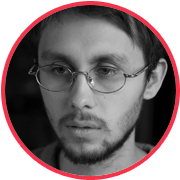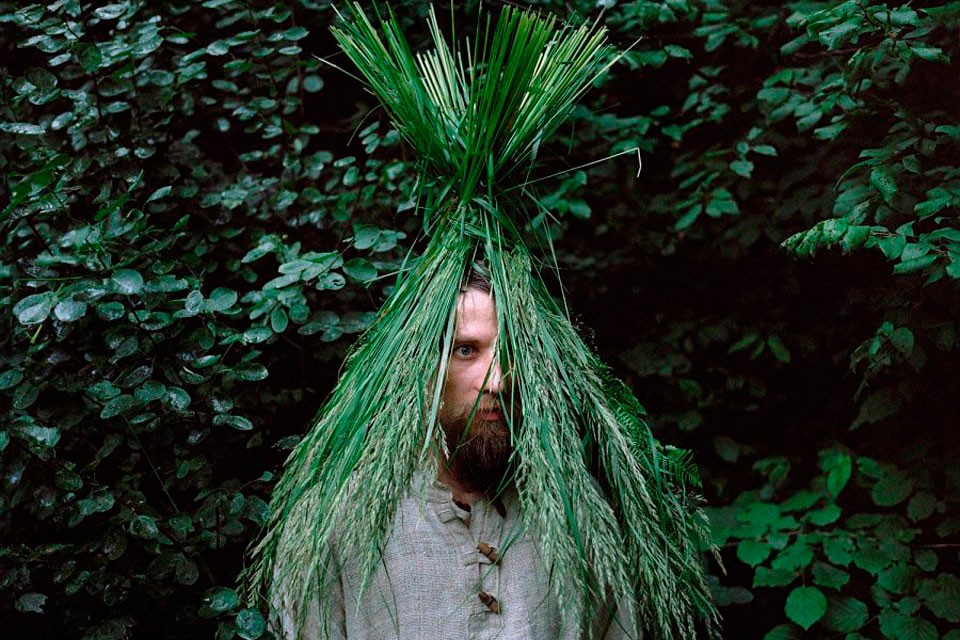Not long ago a project by a young Russian photographer Danila Tkachenko, “Restricted Areas,” won the first prize in the “Series” category of The LensCulture Exposure Awards 2014. Prior to that, Tkachenko’s first project, “Escape,” won in “Staged Portraits”, category of World Press Photo 2014. Tkachenko told Bird In Flight why he quit his job as a newspaper photographer, why he goes travelling and why he won’t reveal the shooting location of “Restricted Areas” and “Escape.”

I became involved with photography after a one-year escape to India. Before that I was in the alcohol business, worked as a barman. When I returned from India, I entered the school of photojournalism, and right after it I got a job at a newspaper. I worked as a photojournalist for some time, but gradually realized that news photography is very often used as a means of political propaganda. And it was not my thing, honestly. Besides, I was already studying at the Moscow School of Photography and Multimedia named after A.Rodchenko. So I had to make a choice to stay at the newspaper or completely give myself over to my studies. I opted for Rodchenko.
{ “img”: “/wp-content/uploads/2015/04/tkachenko06.jpg”, “text”:”From Espace series.” },
{ “img”: “/wp-content/uploads/2015/04/tkachenko_18.jpg”, “text”:”From Espace series.” },
{ “img”: “/wp-content/uploads/2015/04/tkachenko_19.jpg”, “text”:”From Espace series.” },
{ “img”: “/wp-content/uploads/2015/04/tkachenko_20.jpg”, “text”:”From Espace series.” },
{ “img”: “/wp-content/uploads/2015/04/tkachenko_21.jpg”, “text”:”From Espace series.” },
{ “img”: “/wp-content/uploads/2015/04/tkachenko_22.jpg”, “text”:”From Espace series.” },
{ “img”: “/wp-content/uploads/2015/04/tkachenko_23.jpg”, “text”:”From Espace series.” }
The “Escape” project began when I was still at Rodchenko school. The original idea was to photograph communities living away from civilisation. But then I found some hermits and realised that they are much more interesting. I worked on this project for three years, of which I spent a year doing research and looking for hermits. I made phone calls to regional media and forestries, searched the internet, drafted a route, then made a trip. I was shooting all over Russia and even in part of the Ukraine — in the Zhitomir region and the Crimea. I was interested not so much in the people themselves, but the conflict between the man and the society. I was brought up in Moscow, and for me it is a hostile environment. Individualism is condemned in Russia, the society still lives in accordance with communal laws. There are people who feel so uncomfortable in that environment that the only possible escape for them is to go into the wild.
{ “img”: “/wp-content/uploads/2015/04/tkachenko07.jpg”, “text”:”From Espace series.” },
{ “img”: “/wp-content/uploads/2015/04/tkachenko08.jpg”, “text”:”From Espace series.” },
{ “img”: “/wp-content/uploads/2015/04/tkachenko09.jpg”, “text”:”From Espace series.” },
{ “img”: “/wp-content/uploads/2015/04/tkachenko10.jpg”, “text”:”From Espace series.” },
{ “img”: “/wp-content/uploads/2015/04/tkachenko11.jpg”, “text”:”From Espace series.” }
It took me a long time to get to each hermit. At first I would make inquiries about him in the next inhabited place. Sometimes I would come to the assumed location of the hermit’s home, but there would be nothing there or the person would have died. Once on a Moscow subway train I accidentally lost a year’s work, so I had to go back and start looking for the people in the woods one more time. I always came with some gifts, brought food, had long conversations with the hermits and then started shooting. At each place I stayed for a couple of days and nights — the idea was to photograph with the evening light. Sometimes I would stay for a longer time, if the person was interesting to talk to. In fact, many of them are very open and child-like, because they are free of social stereotypes. Or course there were also people who didn’t want to talk to me. I never give any information as to those people’s whereabouts, nor provide anyone’s personal data. The project has become quite popular and I wouldn’t like anyone to start bothering them.
About a year before the completion of the project I started working on a book. It was recently published in Berlin, but the whole circulation of 1300 copies was sold out at once. That series took part in the Month of Photography in Berlin — in Russia there is not so much interest. The first exhibition is only in the negotiation phase.
{ “img”: “/wp-content/uploads/2015/04/tkachenko12.jpg”, “text”:”From Espace series.” }
{ “img”: “/wp-content/uploads/2015/04/tkachenko13.jpg”, “text”:”From Espace series.” }
{ “img”: “/wp-content/uploads/2015/04/tkachenko14.jpg”, “text”:”From Espace series.” }
A month ago I finished my second project, “Restricted Areas,” (I will soon start making a book about it too). It turned out to be very difficult. I would come to the Arctic and wait for the right kind of weather for three months. In that project I wanted to think about technical progress, its use and its consequences, wanted to create a post-apocalyptic world in science fiction style. Because, if you come to think about it, the technical progress is not always such a good thing. It can be used in a mercenary way and be harmful for the people. This project is a metaphor of desolation and death as a result of technical progress.
{ “img”: “/wp-content/uploads/2015/04/tkachenko04.jpg”, “text”:”From Restricted Areas project” }
It all started with a trip to my grandmother who lives in a former restricted town. Actually, it is still a closed place where you can’t go without a special pass. In 1968 there was a nuclear disaster there — of the Chernobyl kind — an accident that was only made public in 1993 when it was of no more concern to anyone. That’s why half of the Urals is contaminated with radiation. When I returned from that place I realized that it would be interesting to find more places of this kind – that used to be very ambitious projects, but then became of totally no interest to anyone. The first images of objects in the midst of a snowstorm were accidental, but then I made up my mind to shoot the whole series the same way. I travelled all over Russia, to the Extreme North, something was photographed in Bulgaria and in Kazakhstan. In this project I give the name of every object, but don’t give the exact geolocation because unfortunately such places are now savagely looted and dismantled to make scrape metal.
In the near future I am going to do a project about depopulated villages.
Photography doesn’t reflect reality. It is in the first place a medium — the same way as text or music. And the question is whether you know how to use it. Any object can be photographed and interpreted in a million ways, and the final result of any such interpretation will always be different from reality. For example, I could have photographed the hermits with smiles on their faces, and then it would have been a totally different project. I call myself an artist who works in documentary photography because today everyone who has an iPhone considers himself a photographer. As for me, by doing each project I try to create a holistic work of art with a lucid message.
I also like photography for the fact that it is a concentrated information stream. I worked on the series for three years, but it takes five minutes to see it. I think it is an advantage in our reality where we almost always lack time. Photography — just like painting at a certain period of time — isnow experiencing the Golden Age and because of the huge number of images there is no point in doing ordinary documentary series. Everything has been photographed, everything has been documented. So the time has come for exciting experiments. Contemporary photography now is closer than ever before to contemporary art, and contemporary art only makes sense when it generates new meanings, creates a new interpretation of the world. That’s actually what I am trying to do through photography.
I like travelling and I work a lot. I think that’s what creates this result. I consider myself a professional traveller. That’s my approach to photography – chose a theme, travel and photograph it. Through photography I research the outside world and communicate with it.
While I was working on my first project, when I was at Rodchenko school, I talked to a lot of tutors. Kurator and art historian Ekaterina Degot said an interesting thing, “Stalin often said that art needs to be national in form but international in meaning. Now we need to do it the other way round – it has to be international in form but national in meaning.” The inspiration source for my visual language is the Düsseldorf school and Scandinavian photography. I like their formalism. A photograph is treated as a symbol without any excessive romanticism.
Also, I like to work with details that often remain unnoticed by viewers. For example, in the “Escape” series there is no sky nor the horizon. Visually, it affects one’s senses. One gets the feeling of something closed, something hidden. Those are techniques that every photographer should always try to find.
I like the 6×7 format — visually, it seems closer to a painting. Film is great in terms of detail and and it is excellent quality, and the 10 frame limit sets a calm, fuss-free shooting tempo. It goes without saying that the equipment influences the aesthetics. You choose the instrument that best suits your idea. If detail is important then surely you need a good big camera, if it is important to be dynamic and unnoticeable a small one with an autofocus goes best.
{ “img”: “/wp-content/uploads/2015/04/tkachenko16.jpg”, “text”:”Escape book cover” },
{ “img”: “/wp-content/uploads/2015/04/tkachenko15.jpg”, “text”:”A page from Escape book” },
{ “img”: “/wp-content/uploads/2015/04/tkachenko17.jpg”, “text”:”Page spread from Escape book” }
Self-education is very important. While I was studying, I set a task for myself to discover a new author every day. Now, as I travel around Russia, I hold free lectures in different cities — that’s my way of sharing my knowledge. In order to be a successful artist and photographer, you need to to keep yourself updated on all the trends in the world contemporary photography, contests, grants, festivals and be able to navigate in all that information.
Rodchenko school helped me to find myself and choose my style, but it didn’t teach me how to promote myself on the art market. And I think that is a problem. Young graduates have no idea as to how to make a living from what they want to do. I make my living entirely from photography, mostly from print sales and commissions from different magazines. Also, for promotion, negotiations and correspondence with curators I have a manager to help me — bureaucracy takes up too much time, and I need to keep working.





